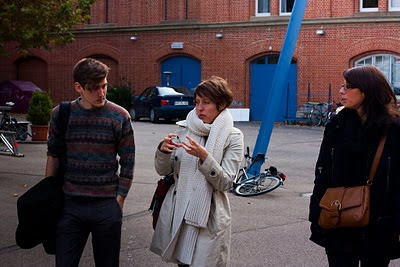The last day of ASF part 1 we spent visiting two big German studios. The first was the relatively young but extremely talented award winning
Studio Soi. This company was founded in 2002 by

graduates from the
Filmakademie and they work across a range of disciplines although most of their output consists of 3d CG films. These are beautifully crafted, earnest, poetic films with real heart. They hark back to a more nuanced way of filmmaking where the shots are longer, the editing more precise and the imagery symbolic, whilst at the same time feeling very fresh and contemporary.
The studio was a large, mostly open plan space with drawing

boards, computers and displays scattered everywhere. Amazing imagery covered the walls, the studios design is fantastic and for the most part is done by one guy –
Jakob Schuh. Their latest project, an adaptation of classic children’s book
The Gruffalo, is commissioned by the BBC, stars a host of British stars as the voice talent and look absolutely beautiful. They used a mixture of stop motion sets with CG characters which look very tactile and clay-like. From the preview we got to see (straight from the cutting room floor so to speak) this blend of the two forms is seamless and the storytelling came across as economic yet epic.

Studio Soi’s Carsten Bunte, Jakob Schuh and Torben Meier
The second studio we visited was
Film Bilder in Sttutgart. This company has been around for a while and has a reputation for producing a wide range of work from the animated sequences in Tom Twkyers brilliant
Run Lola Run to Andreas

Hykade’s sexually charged
Ring of Fire. The studio is situated on the top floor of a very tall building in the centre of Stuttgart with stunning views of the city. We were guided around by
Thomas Meyer-Hermann, the studio head, who gave an insight into the philosophy of the studio and how it has lasted so long, making both experimental short films and more commercial work. The presentation of work he gave was varied and vibrant. He introduced us to ‘Tom’ which is a quite hilarious children’s series they do.

Despite a night of joyous celebration, a large meal with the staff and some dancing, we all left the Filmakademie with heavy hearts, not wanting to leave this company of people. But we won’t be apart for long, we all fly out to Budapest on Sunday for the next part of Animation Sans Frontieres – The Animation Production Workshop.
 Torvald und der Tannenbaum © Studio Soi 2005
Torvald und der Tannenbaum © Studio Soi 2005
TOM © Film Bilder 2003
 Click on the image to watch the sting on the E4 site
Click on the image to watch the sting on the E4 site My armature is nearing completion. I managed to catch up quite quickly having been away after spending a day in the workshop. A little more soldering and gluing to go and then I should have a working armature. Ian very kindly gave us a comprehensive guide to building a stop motion puppet – a summing up of his teachings over the last month or so. I think he’s really inspired the group to become more serious about stop motion and get out there and try making some more models. I’m now anticipating the animation section of the training which starts this week.
My armature is nearing completion. I managed to catch up quite quickly having been away after spending a day in the workshop. A little more soldering and gluing to go and then I should have a working armature. Ian very kindly gave us a comprehensive guide to building a stop motion puppet – a summing up of his teachings over the last month or so. I think he’s really inspired the group to become more serious about stop motion and get out there and try making some more models. I’m now anticipating the animation section of the training which starts this week. 

































